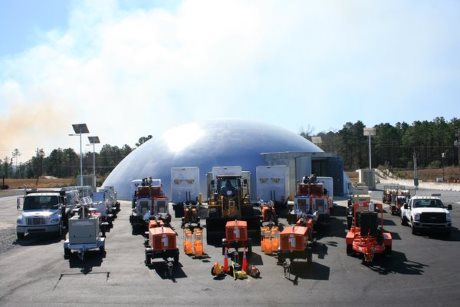A new building designed to withstand earthquakes and tornadoes has been completed at the Hatch nuclear power plant in Georgia. The dome-shaped building will house portable back-up emergency equipment including generators, pumps and other resources.
 |
| The Hatch FLEX dome, and the equipment it will house (Image: Southern Company) |
The Hatch FLEX Dome is nearly 12 metres in height, 46 metres in diameter and features 46-centimetre thick reinforced concrete walls. The building is designed to withstand an earthquake, a direct hit by a tornado, damage from airborne flying objects during a tornado, or similar threats. It will store portable generators, pumps, communication equipment, refuelling equipment and other resources that might be needed if the plant was to experience an extended interruption to its power supplies.
The backup equipment stored in the FLEX Dome is additional to the plant's existing emergency backup systems and would only be put into service in the event that the plant's other redundant resources were depleted or damaged.
The Hatch FLEX Dome has been completed under the US nuclear industry's strategy to implement the recommendations of the Nuclear Regulatory Commission's post-Fukushima task force. When Japan's Fukushima Daiichi plant was struck by an earthquake and tsunami in 2011, the main safety challenges arose from the loss of on-site and off-site power needed to operate the plant's safety cooling systems. Under the initiative, known as FLEX, the industry has developed a series of flexible, diverse strategies using portable equipment to protect the country's nuclear plants against such extreme events.
Dome-shaped buildings offer one option for the safe on-site storage of FLEX equipment. The first FLEX dome was built in 2014 at Dominion's North Anna plant in Virginia, and similar facilities have been built at other sites. Some locations, such as Duke Energy's Harris plant in North Carolina, have been able to use existing buildings.
In addition, two regional response centres have been established in Arizona and Tennessee. These centres provide additional sets of portable back-up equipment kept ready for use at any US nuclear power plant in the event of an emergency.
Hatch site vice president David Vineyard said that safety and preparation at all levels was a top priority for the plant, which is home to two boiling water reactors. "The dome is the most visible part of the FLEX strategy, but we've also made modifications throughout the plant that further strengthen our ability to protect the health and safety of our workers and the public," he said.
Researched and written
by World Nuclear News




_18570.jpg)
_16159.jpg)
_49205.jpg)
_18938.jpg)





